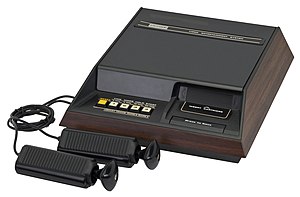Fairchild Channel F

The Fairchild Channel F
|
|
| Manufacturer | Fairchild Semiconductor |
|---|---|
| Type | Home video game console |
| Generation | Second generation |
| Release date | |
| Introductory price | US$169 (equivalent to $711.28 in 2016) |
| Discontinued | 1983 |
| Units sold | 250,000 |
| CPU | Fairchild F8 |
| Removable storage | ROM cartridge |
| Controller input | Joystick/Paddle Keypad (Canceled) |
| Successor | Channel F System II |
The Fairchild Channel F is a home video game console released by Fairchild Semiconductor in November 1976 across North America at the retail price of $169.95. It was also released in Japan in October the following year. It has the distinction of being the first programmable ROM cartridge–based video game console, and the first console to use a microprocessor. It was launched as the Video Entertainment System, or VES, but when Atari released its VCS the next year, Fairchild renamed its machine. By 1977, the Fairchild Channel F had sold 250,000 units, trailing behind sales of the VCS.
The Channel F electronics were designed by Jerry Lawson using the Fairchild F8 CPU, the first public outing of this processor. The F8 was very complex compared to the typical integrated circuits of the day, and had more inputs and outputs than other contemporary chips. Because chip packaging was not available with enough pins, the F8 was instead fabricated as a pair of chips that had to be used together to form a complete CPU.
Lawson worked with Nick Talesfore and Ron Smith. As manager of Industrial Design, Talesfore was responsible for the design of the hand controllers, console, and video game cartridges. Smith was responsible for the mechanical engineering of the video cartridges and controllers. All worked for Wilf Corigan, head of Fairchild Semiconductor, a division of Fairchild Camera & Instrument.
The graphics are quite basic by modern standards. The Channel F is only able to use one plane of graphics and one of four background colors per line, only three plot colors to choose from (red, green, and blue) that turned into white if the background is set to black. A resolution of 128 × 64 with approximately 102 × 58 pixels visible and help from only 64 bytes of system RAM, half the amount of the Atari 2600. The F8 processor at the heart of the console is able to produce enough AI to allow for player versus computer matches, a first in console history. All previous machines required a human opponent.
One feature unique to this console is the 'hold' button, which allowed the player to freeze the game, change the time or change the speed of the game. In the original unit, sound is played through an internal speaker, rather than the TV set. However, the System II passed sound to the television through the RF modulator.
...
Wikipedia
